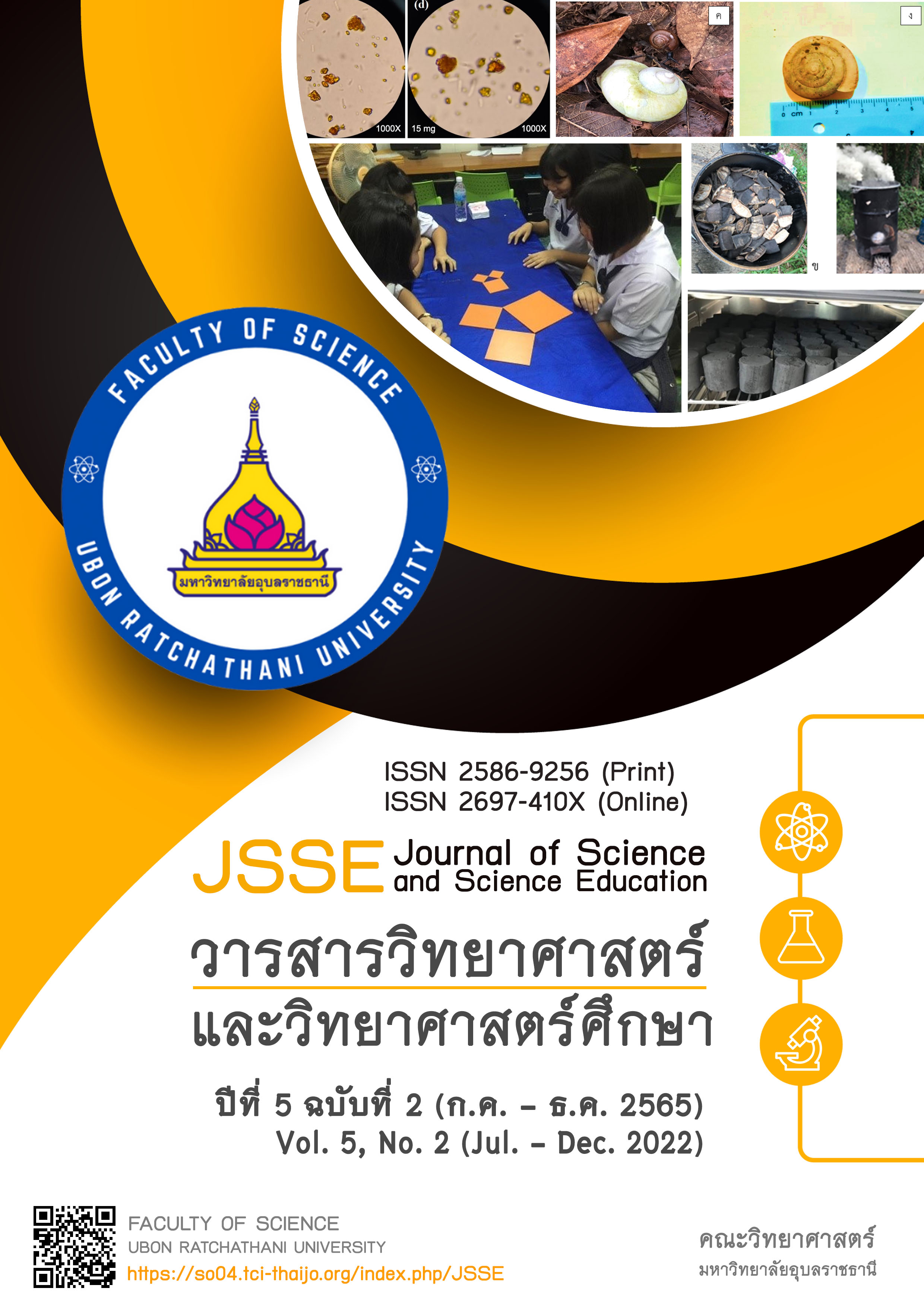ผลเฉลยของสองสมการไดโอแฟนไทน์ n^{2x}+2^y=z^2 และ n^{2x}-2^y=z^2
Main Article Content
บทคัดย่อ
ในงานวิจัยนี้ แสดงว่า ผลเฉลยทั้งหมดที่เป็นจำนวนเต็มที่ไม่เป็นลบของสมการไดโอแฟนไทน์
เมื่อ เป็นจำนวนเต็มบวกคี่ อยู่ในรูป
และผลเฉลยทั้งหมดที่เป็นจำนวนเต็มที่ไม่เป็นลบของสมการไดโอแฟนไทน์ เมื่อ
เป็นจำนวนเต็มบวกคี่
อยู่ในรูป
Article Details

This work is licensed under a Creative Commons Attribution-NonCommercial-NoDerivatives 4.0 International License.
วารสารวิทยาศาสตร์และวิทยาศาสตร์ศึกษา (JSSE) เป็นผู้ถือลิสิทธิ์บทความทุกบทความที่เผยแพร่ใน JSSE นี้ ทั้งนี้ ผู้เขียนจะต้องส่งแบบโอนลิขสิทธิ์บทความฉบับที่มีรายมือชื่อของผู้เขียนหลักหรือผู้ที่ได้รับมอบอำนาจแทนผู้เขียนทุกนให้กับ JSSE ก่อนที่บทความจะมีการเผยแพร่ผ่านเว็บไซต์ของวารสาร
แบบโอนลิขสิทธิ์บทความ (Copyright Transfer Form)
ทางวารสาร JSSE ได้กำหนดให้มีการกรอกแบบโอนลิขสิทธิ์บทความให้ครบถ้วนและส่งมายังกองบรรณาธิการในข้อมูลเสริม (supplementary data) พร้อมกับนิพนธ์ต้นฉบับ (manuscript) ที่ส่งมาขอรับการตีพิมพ์ ทั้งนี้ ผู้เขียนหลัก (corresponding authors) หรือผู้รับมอบอำนาจ (ในฐานะตัวแทนของผู้เขียนทุกคน) สามารถดำเนินการโอนลิขสิทธิ์บทความแทนผู้เขียนทั้งหมดได้ ซึ่งสามารถอัพโหลดไฟล์บทความต้นฉบับ (Manuscript) และไฟล์แบบโอนลิขสิทธิ์บทความ (Copyright Transfer Form) ในเมนู “Upload Submission” ดังนี้
1. อัพโหลดไฟล์บทความต้นฉบับ (Manuscript) ในเมนูย่อย Article Component > Article Text
2. อัพโหลดไฟล์แบบโอนลิขสิทธิ์บทความ (Copyright Transfer Form) ในเมนูย่อย Article Component > Other
ดาวน์โหลด ไฟล์แบบโอนลิขสิทธิ์บทความ (Copyright Transfer Form)
References
Acu, D. (2007). On a Diophantine equation 〖 2〗^x+5^y=z^2. General Mathematics, 15(4), 145-148.
Anbuselvi, R. and Sivasankari, J. (2019). Applications of Diophantine equations in chemical equations. Journal of Emerging Technologies and Innovative Research, 6(6), 371-373.
Burshtein, N. (2018a). On the Diophantine equation〖 2〗^(2x+1)+7^y=z^2. Annals of Pure and Applied Mathematics, 16(1), 177-179. doi: 10.22457/apam.v16n1a19
Burshtein, N. (2018b). Solutions of the Diophantine equation 〖 2〗^x+p^y=z^2 when p is prime. Annals of Pure and Applied Mathematics, 16(2), 471-477. doi: 10.22457/apam.v16n2a25
Chotchaisthit, S. (2012). On the Diophantine equation 〖 4〗^x+p^y=z^2 where p is a prime number. American. Jr. of Mathematics and Sciences, 1(1), 191-193.
Chotchaisthit, S. (2013). On the Diophantine equation〖 2〗^x+11^y=z^2. Maejo International Journal of Science and Technology, 7(2), 291-293.
Dhurga, C.K. (2021). A linear Diophantine equation and its real life applications. Advances and Applications in Mathematical Sciences, 20(8), 1389-1394.
Kaur, D. and Sambhor, M. (2017). Diophantine equations and its applications in real life. International Journal of Mathematics and its applications, 5(2), 217-222.
Khan, M.A.A., Rashid, A. and Uddin, M.S. (2016). Non-negative integer solutions of two Diophantine equations 〖 2〗^x+9^y=z^2 and〖 5〗^x+9^y=z^2. Journal of Applied Mathematics and Physics, 4, 762-765. doi: 10.4236//jamp.2016.44086
Mihailescu, P. (2004). Primary cyclotomic units and a proof of Catalan’s conjecture. Journal für die Reine und Angewante Mathematik, 27, 167-195.
Puangjumpa, P. (2016). Possible solution of the Diophantine equation〖 2〗^x+47^y=z^2. Academic Journal URU, 11(3S), 36-42.
Qi, L. and Li, X. (2015). The Diophantine equation〖 8〗^x+p^y=z^2. The Scientific World Journal, Article ID 306590, 3 pages. doi: 10.1155/2015/306590
Rabago, J.F.T. (2016). On the Diophantine equation〖 2〗^x+17^y=z^2. Journal of the Indonesian Mathematical Society, 22(2), 177-181.
Sroysang, B. (2013). More on the Diophantine equation〖 2〗^x+3^y=z^2. International Journal of Pure and Applied Mathematics, 84(2), 133-137. doi: 10.12732/ijpam.v84i2.11
Suvarnamani, A., Singta, A. and Chotchaisthit, S. (2011). On two Diophantine equations 〖 4〗^x+7^y=z^2 and 〖 4〗^x+11^y=z^2. Science and Technology RMUTT Journal, 1(1), 25-28.
Tanakan, S. (2014). On the Diophantine equation〖 19〗^x+2^y=z^2. International Journal of Contemporary Mathematical Sciences, 9(4), 159-162. doi: 10.12988/ijcms.2014.418
Chotchaisthit, S. (2012). On the Diophantine equation 4^x+p^y=z^2 where p is a prime number. American. Jr. of Mathematics and Sciences, 1(1), 191-193.
Chotchaisthit, S. (2013). On the Diophantine equation 2^x+11^y=z^2. Maejo International Journal of Science and Technology, 7(2), 291-293.
Dhurga, C.K. (2021). A linear Diophantine equation and its real life applications. Advances and Applications in Mathematical Sciences, 20(8), 1389-1394.
Kaur, D. & Sambhor, M. (2017). Diophantine equations and its applications in real life. International Journal of Mathematics and its applications, 5(2), 217-222.
Khan, M.A.A., Rashid, A. & Uddin, M.S. (2016). Non-negative integer solutions of two Diophantine equations 2^x+9^y=z^2 and 5^x+9^y=z^2. Journal of Applied Mathematics and Physics, 4, 762-765. doi: 10.4236//jamp.2016.44086
Mihailescu, P. (2004). Primary cyclotomic units and a proof of Catalan’s conjecture. Journal für die Reine und Angewante Mathematik, 27, 167-195.
Puangjumpa, P. (2016). Possible solution of the Diophantine equation 2^x+47^y=z^2. Academic Journal URU, 11(3S), 36-42.
Qi, L. & Li, X. (2015). The Diophantine equation 8^x+p^y=z^2. The Scientific World Journal, Article ID 306590, 3 pages. doi: 10.1155/2015/306590
Rabago, J.F.T. (2016). On the Diophantine equation 2^x+17^y=z^2. Journal of the Indonesian Mathematical Society, 22(2), 177-181.
Sroysang, B. (2013). More on the Diophantine equation 2^x+3^y=z^2. International Journal of Pure and Applied Mathematics, 84(2), 133-137. doi: 10.12732/ijpam.v84i2.11
Suvarnamani, A., Singta, A., & Chotchaisthit, S. (2011). On two Diophantine equations 4^x+7^y=z^2 and 4^x+11^y=z^2. Science and Technology RMUTT Journal, 1(1), 25-28.
Tanakan, S. (2014). On the Diophantine equation 19^x+2^y=z^2. International Journal of Contemporary Mathematical Sciences, 9(4), 159-162. doi: 10.12988/ijcms.2014.418

